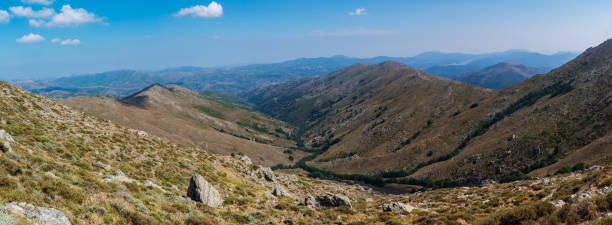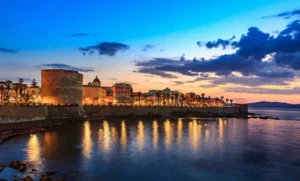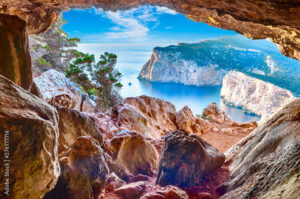 I
I
Introduction to Sardinia 2023: The Island’s Hidden Secrets
Welcome to your comprehensive Sardinia travel guide. A world of captivating charm awaits you, ready to be discovered. Nestled in the Mediterranean Sea, Sardinia is a paradise island that holds the secrets of an ancient and fascinating history, a rich cultural heritage and breathtaking natural beauty. Whether you’re a history buff, a nature enthusiast or a gastronomy lover, Sardinia is a destination that will satisfy every traveller’s curiosity.
Where exactly is Sardinia? – let’s answer that question here!
The island’s hidden secrets are patiently waiting to be unveiled by those ready to explore Sardinia. From the prehistoric Nuragic civilization and the enchanting folklore, to the mouth-watering traditional cuisine and the pristine beaches, Sardinia is a world in itself, a microcosm where time seems to have stopped, allowing traditions to be preserved and local life to flourish.
This Sardinia travel guide is designed to help you discover Sardinia’s beauty, understand its deep-rooted culture and history, and provide you with all the necessary tips and information for a memorable Sardinia vacation. So, let’s set sail on this exciting journey together and unlock the island’s secrets.
Understanding Sardinia
Sardinia’s Geographical Location and Unique Features

Situated in the Mediterranean Sea, Sardinia is the second largest island in the region. Its unique geographical location, between Italy, Spain and North Africa, has influenced the island’s history, culture and way of life. One of the most distinctive features of Sardinia is its varied landscape, which ranges from the dramatic cliffs of the Costa Smeralda and the vast plains of the Campidano, to the rugged mountains of the Gennargentu range and the pristine white sandy beaches along its coastline.
The island’s flora and fauna are another testament to its unique geographical position. Sardinia hosts a variety of endemic species, making it a biodiversity hotspot and a paradise for nature enthusiasts. Exploring Sardinia’s natural wonders is undoubtedly a highlight of any Sardinia tourism experience.
Overview of the Island’s History and Cultural Heritage

Sardinia has a rich and diverse history, which dates back to the prehistoric times. The island was home to the Nuragic civilization, and its numerous Nuraghe (stone-built tower-fortresses) are a testament to this ancient culture. Over the centuries, Sardinia was influenced by various cultures including the Phoenicians, Romans, Arabs, and Spanish, each leaving their mark on the island’s cultural heritage.
Sardinia’s culture is a vibrant blend of traditions, folklore, music, and dance. The island is known for its distinct language, Sardinian, which is considered a romance language separate from Italian. Sardinians are also famed for their longevity, with the island being one of the world’s five ‘Blue Zones’ where people live the longest.
Why Choose Sardinia for Your Vacation
Choosing Sardinia for your vacation means immersing yourself in an authentic Mediterranean experience. It’s a place where you can truly disconnect from the hustle and bustle of modern life, and reconnect with nature and culture. The island’s stunningly beautiful beaches, crystal clear waters, and breathtaking landscapes make it an ideal destination for relaxation and adventure.
Sardinia offers a wealth of activities for travellers. From exploring the island’s rich history and culture, to enjoying water sports, diving, hiking, and cycling, there are countless things to do in Sardinia. And let’s not forget the gastronomic delights. The island’s unique cuisine is a culinary journey in itself, offering a myriad of flavours to tantalise your taste buds.
Check out our FAQs about Sardinia!
Discovering Sardinia’s Beauty: Key Sights and Attractions
Top Places to Visit in Sardinia
Sardinia is teeming with attractions that cater to all tastes. Whether you’re interested in history, culture, nature, or simply relaxation, you’ll find plenty of places to visit on this enchanting island.
Cagliari: The Capital City’s Historic Landmarks and Modern Charm
Cagliari, Sardinia’s capital city, is a bustling metropolis that perfectly blends the old with the new. Its historic quarter, Castello, is home to medieval fortifications, narrow cobbled streets, and grand palaces. Visit the Cathedral of Santa Maria, the Royal Palace, and the Bastion of Saint Remy for a dose of history. The modern part of the city offers chic boutiques, trendy restaurants, and a vibrant nightlife.
Alghero: The Catalan-Infused Town on the Northwest Coast
Alghero, known as ‘little Barcelona’, is a charming town that bears Catalan influences. Its old town is a labyrinth of narrow alleys lined with Gothic buildings. Visit the imposing Cathedral of Santa Maria and the Tower of Porta Terra. Don’t miss the chance to explore the nearby Neptune’s Grotto, an impressive stalactite cave.
Olbia: Gateway to the Costa Smeralda and Nearby Attractions
Olbia is often the first stop for tourists due to its international airport and ferry port. However, this city is more than just a gateway to the famous Costa Smeralda. Visit the Basilica of San Simplicio, the Roman Aqueduct, and the Archaeological Museum. Nearby attractions include the stunning beaches of the Costa Smeralda and the Giants’ Grave in Arzachena.
Nuoro: The Heart of Sardinian Culture and Traditions
Nuoro is often referred to as the cultural heart of Sardinia. It is home to numerous museums, including the Ethnographic Museum and the Museum of Sardinian Life and Traditions. This city is also a good base for exploring the stunning Gennargentu National Park.
Oristano: Rich Historical Sites and Coastal Beauty
Oristano is a city that exudes historical charm. Visit the Tower of St. Christopher, the Cathedral of Santa Maria Assunta, and the Archaeological Museum. The nearby Sinis Peninsula and the Tharros archaeological site are also worth a visit.
Sassari: Exploring the Vibrant Cultural Hub of the North
Sassari, Sardinia’s second largest city, is a cultural and educational hub. Visit the Piazza d’Italia, the Cathedral of St. Nicholas, and the National Museum. Don’t miss the annual Cavalcade of Sassari, a grand folkloric event.
Porto Cervo: The Glamorous Allure of the Costa Smeralda
Porto Cervo is the heart of the glamorous Costa Smeralda. Known for its luxury yachts, upscale boutiques, and high-end restaurants, this town is a playground for the rich and famous. Enjoy the beautiful beaches and the lively nightlife.
Bosa: Picturesque Charm on the Temo River
Bosa is a picturesque town located on the banks of the Temo River. Its colourful houses, the Malaspina Castle, and the Bosa Cathedral are must-sees. Also, don’t forget to try the local Malvasia wine.
Cala Gonone: Unveiling the Wonders of the Gulf of Orosei
Cala Gonone is a seaside village that serves as a gateway to the stunning Gulf of Orosei. Explore the beautiful beaches, the Bue Marino Caves, and the Gennargentu National Park.
Costa Rei: Relaxation and Leisure on Sardinia’s Southeastern Coast
Costa Rei, on Sardinia’s southeastern coast, is known for its beautiful beaches, clear waters, and leisure activities. Relax on the beach, enjoy water sports, or explore the nearby Capo Ferrato Nature Reserve.
Sardinia’s Must-See Landmarks

Sardinia’s landmarks are a testament to its rich history and cultural heritage. The Nuraghe, ancient stone towers scattered across the island, are perhaps the most iconic landmarks. The most famous is Su Nuraxi in Barumini, a UNESCO World Heritage Site.
Other must-see landmarks include the Basilica of San Gavino in Porto Torres, one of the oldest churches in Sardinia, and the Neptune’s Grotto in Alghero, an impressive stalactite cave. The Giants’ Graves, ancient megalithic tombs, and the sacred wells, like the Well of Santa Cristina, are also worth a visit.
- Nuraghe Su Nuraxi (Barumini) : One of Sardinia’s most iconic landmarks, Nuraghe Su Nuraxi is a UNESCO World Heritage site dating back to the Bronze Age. This well-preserved nuraghe complex features a central tower surrounded by defensive walls and interconnected chambers, providing a fascinating glimpse into Sardinia’s ancient Nuragic civilization.
- Alghero’s Old Town : Nestled on Sardinia’s northwest coast, Alghero’s Old Town is a picturesque gem known for its Catalan heritage and medieval charm. Stroll through narrow cobblestone streets, admire historical buildings, and enjoy the stunning sea views along the city walls.
- Cagliari’s Castello District : The historic Castello district in Cagliari, the island’s capital, boasts a majestic hilltop fortress, ancient walls, and beautiful architecture. Wander through its ancient alleys, visit the Cagliari Cathedral, and enjoy panoramic views of the city and sea.
- Neptune’s Grotto (Grotta di Nettuno) : Located on the dramatic Capo Caccia cliffs near Alghero, Neptune’s Grotto is a mesmerizing sea cave accessible by boat or a scenic hike down the 656-step Escala del Cabirol staircase. Inside, marvel at stunning stalactites, stalagmites, and underground lakes.
- Tiscali Nuragic Village : Hidden within a limestone mountain near Dorgali, Tiscali Nuragic Village offers a unique archaeological site. Accessible through a scenic hike, the village is nestled inside a large cave and showcases well-preserved remnants of Nuragic structures.
- Roman Amphitheatre (Teatro Romano) – Cagliari S: Unearth the ancient past of Cagliari at the Roman Amphitheatre, which dates back to the 2nd century AD. Marvel at the well-preserved ruins, including seating tiers and the arena, and learn about the rich history of the Roman era.
- La Maddalena Archipelago Take a boat tour to explore the breathtaking beauty of La Maddalena Archipelago, a national park comprising seven main islands and numerous islets. Discover secluded beaches, crystal-clear waters, and unique rock formations.
- Giants’ Tombs (Tomba dei Giganti): Giants’ Tombs are ancient burial sites scattered across Sardinia, characterized by impressive megalithic structures. These prehistoric monuments provide a glimpse into the island’s early civilizations and burial rituals.
- Tharros Archaeological Site : Situated on the Sinis Peninsula, the Tharros Archaeological Site offers well-preserved ruins of an ancient Phoenician and Roman city. Explore ancient temples, bathhouses, and a theater, all overlooking the Mediterranean Sea.
- Basilica of San Gavino (Porto Torres) Summary: The Basilica of San Gavino in Porto Torres is an extraordinary example of Sardinia’s early Christian heritage. This Romanesque church features intricate architecture and stunning frescoes, making it a significant religious and historical site.
Learn all about the best beaches in Sardinia
Things to Do in Sardinia: Activities and Experiences
Sardinia offers a wealth of activities for travellers. Hiking and cycling are popular ways to explore the island’s diverse landscapes. The Gennargentu National Park and the Supramonte are prime locations for outdoor activities.
Water sports enthusiasts can enjoy scuba diving, snorkelling, surfing, and sailing. The Costa Smeralda and the Gulf of Orosei are popular spots for these activities.
For culture vultures, attending a traditional Sardinian festival is a must. The Carnival of Tempio Pausania, the Sagra del Redentore in Nuoro, and the Cavalcade of Sassari are among the most famous.
Sardinia’s Unique Cuisine: A Gastronomic Journey
Sardinian cuisine is a gastronomic journey that reflects the island’s history, culture, and agricultural bounty. Traditional dishes are simple but full of flavour. Try the “porceddu” (roasted suckling pig), the “malloreddus” (Sardinian gnocchi), and the “bottarga” (mullet roe).
Sardinia is also known for its bread, cheese, and wine. The “pane carasau” (flatbread), the “pecorino sardo” (sheep’s milk cheese), and the Cannonau wine are must-tries. For more information read our guide on what to drink when in Sardinia.
5 Sardinian Foods you Must Try!

- Pasta alla Bottarga: A classic Sardinian dish featuring pasta (commonly spaghetti) topped with grated bottarga, which is dried and salted gray mullet roe. The bottarga adds a unique umami flavor to the pasta, creating a delightful and savory dish.
- Porceddu: Porceddu is a traditional Sardinian dish of roasted suckling pig, seasoned with aromatic herbs such as myrtle and rosemary. The meat is slow-roasted to perfection, resulting in tender, juicy, and flavorful pork.
- Culurgiones: Culurgiones are Sardinian stuffed pasta, similar to ravioli but with a unique twist. The dough is filled with a delicious mixture of potatoes, pecorino cheese, and mint, then shaped into small pockets and served with a simple tomato sauce or butter and sage.
- Fregola con Arselle: Fregola is a type of small, round pasta similar to couscous. Fregola con Arselle is a delightful seafood dish made with fregola cooked in a flavorful broth with fresh clams (arselle) and sometimes other seafood like shrimp or mussels.
- Seadas: Seadas, also known as sebadas or seadas, is a traditional Sardinian dessert. It consists of a delicious combination of deep-fried pastry filled with a mixture of fresh cheese (such as pecorino or ricotta) and lemon zest. Once fried, the seadas are drizzled with honey, creating a perfect balance of sweet and savory flavors.
Learn more about vegetables of Sardinia
Sardinia Travel Tips: What to Know Before You Go
Best Time to Visit: Understanding Sardinia’s Weather
Sardinia has a Mediterranean climate with hot, dry summers and mild, rainy winters. The best time to visit depends on what you want to do. For beach holidays, the summer months from June to September are ideal. For hiking and sightseeing, the spring (April-May) and autumn (October-November) offer pleasant weather.
Average Month-by-month temperature in Sardinia
| Month | Min (°C) | Max (°C) | Mean (°C) | Min (°F) | Max (°F) | Mean (°F) |
|---|---|---|---|---|---|---|
| January | 4.9 | 14.3 | 9.6 | 41 | 58 | 49.3 |
| February | 4.6 | 14.5 | 9.6 | 40 | 58 | 49.2 |
| March | 6.2 | 16.6 | 11.4 | 43 | 62 | 52.5 |
| April | 8.2 | 19.3 | 13.8 | 47 | 67 | 56.8 |
| May | 11.6 | 23.6 | 17.6 | 53 | 75 | 63.7 |
| June | 15.4 | 28.1 | 21.7 | 60 | 83 | 71.1 |
| July | 18 | 31.1 | 24.5 | 64 | 88 | 76.1 |
| August | 18.2 | 31.5 | 24.9 | 65 | 89 | 76.8 |
| September | 15.7 | 27.4 | 21.6 | 60 | 81 | 70.9 |
| October | 12.8 | 23.7 | 18.3 | 55 | 75 | 64.9 |
| November | 9.2 | 18.7 | 14 | 49 | 66 | 57.2 |
| December | 6.3 | 15.4 | 10.9 | 43 | 60 | 51.5 |
| Year | 11 | 22.1 | 16.5 | 51.8 | 71.7 | 61.5 |
Planning Your Sardinia Vacation: Practical Information and Resources
When planning your Sardinia vacation, consider the length of your stay, your budget, and your interests. Book accommodation and transportation in advance, especially during the peak season. Check the local customs and regulations, and learn a few words in Italian or Sardinian. It’s also a good idea to buy a good Sardinia travel guide book or download a Sardinia travel guide app.
Read our compressive guide on airports in Sardinia
Closing Thoughts: Making the Most of Your Sardinia Holidays
Sardinia is a destination that captivates the senses. Its enchanting beauty, rich history and culture, and warm hospitality make it a place that leaves a lasting impression. Whether you’re seeking adventure, relaxation, or culinary delights, Sardinia offers an unforgettable travel experience.
This comprehensive Sardinia travel guide aims to help you make the most of your Sardinia holidays. So, pack your bags, set your spirit of adventure free, and get ready to unlock the island’s secrets. Sardinia awaits you!



